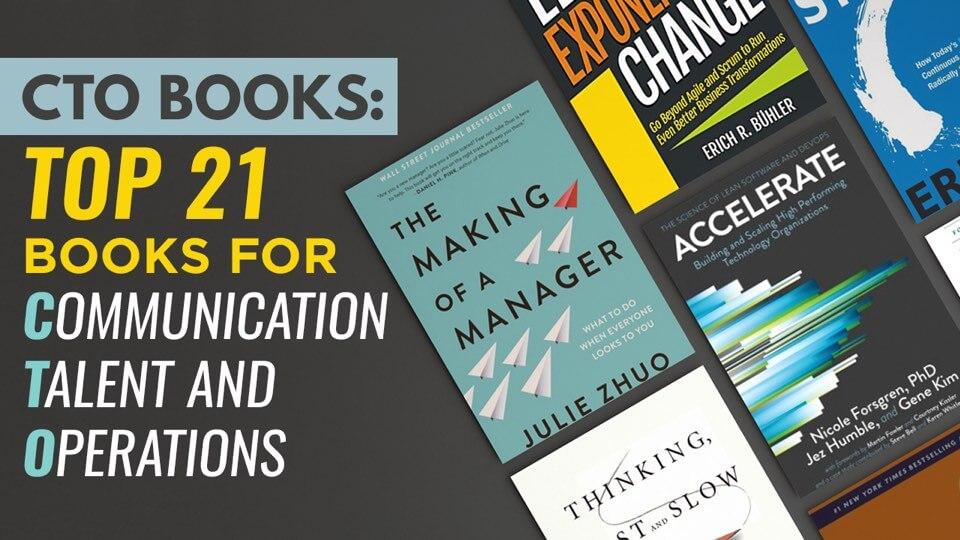Given that technology continues to evolve at an increasingly faster pace, it is a must to grow alongside it. Learning and re-learning the industry’s knowledge is imperative to stay abreast of the latest developments.
Each year, there are many books published containing information and hacks for business and tech executives. They contain helpful tips to help you succeed both personally and professionally. Amidst this overwhelming selection of books.
We’ve selected the top 21 in three key areas: Communication, Talent, and Operation. We focused our recommendations on these three key areas as these skills provide the foundation every CTO needs to excel in their role.
- Top 7 Communication Skills books for CTO
- Bringing Out the Best in People
- How to Win Friends and Influence People
- Crucial Conversations: Tools for Talking When Stakes Are High
- Never Eat Alone, Expanded and Updated
- Thanks for the Feedback: The Science and Art of Receiving Feedback Well
- Thinking, Fast and Slow
- Resonate: Present Visual Stories that Transform Audiences
- Top 7 books on Talent Management for CTO
- The Making of a Manager: What to Do When Everyone Looks to You
- Managing Humans: Biting and Humorous Tales of a Software Engineering Manager
- First, Break All the Rules: What the world's Greatest Managers Do Differently
- Extreme Ownership: How U.S. Navy SEALs Lead and Win
- Dare to Lead: Brave Work. Tough Conversations. Whole Hearts.
- Tribal Leadership: Leveraging Natural Groups to Build a Thriving Organization
- Team Topologies: Organizing Business and Technology Teams for Fast Flow
- Top 7 Operations books for CTO
- The Hard Thing About Hard Things
- Measure What Matters: How Google, Bono, and the Gates Foundation Rock the World with OKRs
- Accelerate: The Science of Lean Software and DevOps: Building and Scaling High Performing Technology Organizations
- Scaling Up Excellence: Getting to More Without Settling for Less
- Leading Exponential Change: Go Beyond Agile and Scrum to Run Even Better Business Transformations
- No Rules Rules: Netflix and the Culture of Reinvention
- The Lean Startup
- Summary
Top 7 Communication Skills books for CTO
Communication is one of the most difficult and feared skills. But it is worth the trouble when mastered. Whether written or spoken, communicating with other people can be intimidating even with family and friends.
Many people struggle with communicating with other people in clear and concise terms. Although tricky, communicating with others is essential for any successful CTO. Companies that use an effective communications strategy already have an upper hand in the market. Furthermore, executives capable of instigating action with their words are well-loved and highly-regarded.
Effective communication is a life skill that everyone ought to have. Investing in advancing your communication skills will help you grow to reach your fullest potential. Whether you are a born communicator or developing yourself to be one, these books will help you develop these skills. Let out the communication master in you with these books.

Bringing Out the Best in People
by Aubrey C. Daniels
This is a great book that contains loads of helpful information and advice on how to communicate with others effectively. Anyone that wants to improve their people skills can learn a lot from it.
It is ideal for managers or anyone leading a team. The author explains everything in a clear way and provides steps to help leaders handle different situations and encourage better overall team performance from team members.

How to Win Friends and Influence People
by Dale Carnegie
Written in 1936, Dale Carnegie’s “How to Win Friends and Influence People” is a timeless treasure. It is one of the best selling books ever.
The book focuses on strategies for creating and maintaining powerful relationships. This is key because your success is directly tied to the relationships you cultivate and the power of those relationships.
He discusses principles such as appealing to what is in your colleague’s interest rather than focusing narrowly on your own self-interest, the importance of memorizing the names of others, and the lost art of listening.
Carnegie focuses on the power of being genuinely interested in other people, which is critical. The book is a reminder that people will accept your advice, act on your recommendations if they like you and IF they believe you like them. They will not follow you based solely on your leadership position or your rank in an organization.
There are so many communications gems in this book, that it deserves an article unto itself. Suffice it to say, this is a book you should buy yesterday. It is seriously that good.

Crucial Conversations: Tools for Talking When Stakes Are High
by Kerry Patterson, Joseph Grenny, Ron McMillan and Al Switzler
If you want to improve your communication skills, this is an excellent book to read! It gives lots of insights into relationships, interactions, and human psyche to give valuable advice.
This can be applied to your relationship with your boss and colleagues, business clients, and customers; and it can also be used in your personal relationships with friends, your spouse, and family members.

Never Eat Alone, Expanded and Updated
by Keith Ferrazzi and Tahl Raz
Most of us understand the importance of building strong connections. But, if it’s networking and building a personal network that’s of interest to you, Never Eat Alone is ideal. This book looks at the importance of networking and growing your network, plus how to do it.
For anyone in business or looking to move forward rapidly in their career, this is a great book that provides lots of actionable advice and suggestions.

Thanks for the Feedback: The Science and Art of Receiving Feedback Well
by Douglas Stone and Sheila Heen
The ultimate guide to effective teamwork and accepting feedback, which is a key part of communication.
The authors outline the barriers to this and explain how reacting negatively to feedback affects the relationship. This is a fantastic practical guide on accepting feedback in a mature, constructive way. We recommend this book for self-improvement and having better interactions!

Thinking, Fast and Slow
by Daniel Kahneman
A widely heralded book when it was released in 2011, Kahneman examines the different types of human thinking — the faster, more emotionally driven side, and the more logical one.
For Juergen Mueller, the chief technology officer at German software firm SAP, the teachings can be applied to improve performance in everyday job tasks.
"Adopting this knowledge in presentations, communication and conversations can make a huge difference," he told Business Insider.

Resonate: Present Visual Stories that Transform Audiences
by Nancy Duarte
Presentations are meant to inform, inspire, and persuade audiences. So why then do so many audiences leave feeling like they've wasted their time? All too often, presentations don't resonate with the audience and move them to transformative action.
Just as the author's first book helped presenters become visual communicators, Resonate helps you make a strong connection with your audience and lead them to purposeful action. The author's approach is simple: building a presentation today is a bit like writing a documentary. Using this approach, you'll convey your content with passion, persuasion, and impact.
Top 7 books on Talent Management for CTO
It may come as no surprise that a sound talent management plan can set a business strategy in full motion. As Rohan, the CTO at Fundera, put it, “Finding the best folks in the early day can make or break your startup. It’s seldom the idea and more often the execution – you need the right people to make that happen. Once we had the right people, product direction and company vision became clearer and easier to iterate.” Furthermore, Rohan believed that recruiting talents is only a fraction of the equation. The other, more critical half lies in retaining the best and brightest talents after recruitment. Thus, implementing a solid talent management strategy is of utmost importance.
As established, an organization is nothing without its talents. Thus, investing in talent management is crucial for carrying out business strategies. It also sends a clear message that the organization values its employees' abilities and contributions. With that, here are the books to consider to manage better and hone your abilities.

The Making of a Manager: What to Do When Everyone Looks to You
by Julie Zhuo
With nearly ten years as a manager under her belt, Julie offers practical advice, relatable anecdotes, questions and exercises for modern managers looking to improve their leadership skills.
She defines three areas that all managers should focus on to get a high multiplier effect:
- Purpose (Why) - "The first big part of your job as a manager is to ensure that your team knows what success looks like and cares about achieving it."
- People (Who) - "To manage people well, you must develop trusting relationships with them, understand their strengths and weaknesses (as well as your own), make good decisions about who should do what (including hiring and firing when necessary), and coach individuals to do their best."
- Process (How) - "For managers, important processes to master include running effective meetings, future proofing against past mistakes, planning for tomorrow, and nurturing a healthy culture."
"I wish I'd had this book when I started managing a team at Instagram. Julie covers the full range of becoming a manager, from your first meetings with your team to accomplishing huge goals together." — Mike Krieger, co-founder of Instagram

Managing Humans: Biting and Humorous Tales of a Software Engineering Manager
by Michael Lopp
This book is a collection of the author’s blog posts he’s written over the course of his career as a manager at Apple, Netscape, Borland, and Symantec, among others.
Author goes over the basics of running a team and contains tactical suggestions on how to play common scenarios like: bad meetings, employee freakouts, and dealing with burnt-out staff. And he does it with a lot of humor.

First, Break All the Rules: What the world's Greatest Managers Do Differently
by Marcus Buckingham and Curt Coffman
This longtime management bestseller presents the remarkable findings of its massive in-depth study of great managers conducted by Gallup. Some were in leadership positions, others were front-line supervisors. Whatever their circumstances, the managers who ultimately became the focus of Gallup’s research were those who excelled at turning each individual employee’s talent into high performance.
Gallup has found that the front-line manager is the key to attracting and retaining talented employees. This book explains how the best managers select an employee for talent rather than for skills or experience, set expectations, build on each person’s unique strengths rather than trying to fix his or her weaknesses, and get the best performance out of their teams.

Extreme Ownership: How U.S. Navy SEALs Lead and Win
by Jocko Willink and Leif Babin
"These leaders cast no blame. They made no excuses. Instead of complaining about challenges or setbacks, they developed solutions and solved problems. They leveraged assets, relationships, and resources to get the job done. Their own egos took a back seat to the mission and their troops. These leaders truly led." ― Jocko Willink
Taking responsibility is the essence of Extreme Ownership. As a leader you must admit failures, take ownership of them and develop a plan to turn them around.
Once people stop making excuses, stop blaming others, and take ownership of everything in their lives, they are compelled to take action to solve their problems.

Dare to Lead: Brave Work. Tough Conversations. Whole Hearts.
by Brené Brown
Brene's research has led her to some very helpful insights about leadership, courage and vulnerability. She describes that in unhealthy organizations there is "too much shame and blame, not enough accountability and learning."
It is so tempting for leaders, who want to gain the trust of their team, to have all the answers, never make mistakes, never mess-up, and always make the right decisions. That’s impossible. And, those trying to prove they never mess up are leaders we don’t want to follow.
"With Dare to Lead, Brené brings decades of research to bear in a practical and insightful guide to courageous leadership. This book is a road map for anyone who wants to lead mindfully, live bravely, and dare to lead." — Sheryl Sandberg, COO, Facebook

Tribal Leadership: Leveraging Natural Groups to Build a Thriving Organization
by Dave Logan, John King, and Halee Fischer-Wright
From a 10-year field study of 24,000 people in two dozen organizations worldwide, the authors found that there are 5 tribal stages that define how people work and behave.
"Life Sucks" - people in this stage talk as if life has treated them badly. Their language includes “not fair”, “f***ed up”, or “do what I must to survive”.
"My Life Sucks" - when people see that others have power and success in life that they lack, feel silently angry and frustrated, but blame others for their lack of control. People at that stage are always skeptical of anything that is proposed to them.
"I’m Great (and You’re Not)" - people act like lone warriors, and are constantly frustrated by the lack of time and support. Their language centers around "I", "me", and "my".
"We’re Great" - This is when the team considers themselves the best and can produce high-quality great work. However, there is always an enemy to the group — "we are great but they are not".
"Life is Great" - people go beyond beating others to expand their impact on the world. The language centers on infinite potential, and how to make history.
If you don’t have time, the book includes cheat sheet at the end that provides a very good summary of how to move the tribes through the stages and coaching tips.

Team Topologies: Organizing Business and Technology Teams for Fast Flow
by Matthew Skelton and Manuel Pais (Author)
In Team Topologies DevOps consultants Matthew Skelton and Manuel Pais share secrets of successful team patterns and interactions to help readers choose and evolve the right team patterns for their organization, making sure to keep the software healthy and optimize value streams.
"Team Topologies provides a much-needed framework for evaluating and optimizing team organization for increased flow. Teams that have the right size, the right boundaries, and the right level of communication are poised to deliver value to the company and satisfaction to the team members. Team Topologies combines a methodical approach with real-world case studies to unlock the full potential of your tech teams." -- Greg Burrell, Technical Product Manager at Netflix
Top 7 Operations books for CTO
Most CTOs are responsible for a broad range of activities — including technology strategy and governance, business systems, technology innovation, and product development.
As Luis Weir, Senior Director at Oracle, said: “A good CTO should not get lost in the woods, but rather take a ‘helicopter view’ approach to understand what the business needs are, where the business is going, and how technology can enable the business to achieve its goals.”
Today, most organizations are in a difficult position as they struggle to keep up with advancing technologies. This need for relevancy poses the same challenge for CTOs. As IT moves towards being a profitable asset, CTOs must also evolve. They need a strong understanding of their organization to drive profitable initiatives. With these books, CTOs can set their vision and direction without having to compromise their priorities.

The Hard Thing About Hard Things
by Ben Horowitz
Ben Horowitz one of Silicon Valley’s tech entrepreneur, investor gives honest entrepreneur advice for CTOs on how successfully run a tech startup and how not to screw up.
The book covers everything starting from challenges, negotiations, dismissal, hiring developers, to managing your motivated team. Humor, honesty, and straightforwardness mirrored on each page in this fanatic business book.
"Hard things are hard because there are no easy answers or recipes. They are hard because your emotions are at odds with your logic. They are hard because you don’t know the answer and you cannot ask for help without showing weakness." – Ben Horowitz

Measure What Matters: How Google, Bono, and the Gates Foundation Rock the World with OKRs
by John Doerr
OKRs focus effort and foster coordination. They keep employees on track. They link objectives across silos to unify and strengthen the entire company. Along the way, OKRs enhance workplace satisfaction and boost retention.
In Measure What Matters, Doerr shares a broad range of first-person, behind-the-scenes case studies to demonstrate the focus, agility, and explosive growth that OKRs have spurred at so many great organizations. This book will help a new generation of leaders capture the same magic.
"I’d recommend John’s book for anyone interested in becoming a better manager." — Bill Gates

Accelerate: The Science of Lean Software and DevOps: Building and Scaling High Performing Technology Organizations
by Nicole Forsgren, Jez Humble, and Gene Kim
A data-driven study showing which practices correlate with high-performing teams and organisations. To some, the outcomes of the author’s research may sound quite natural and not very surprising but the evidence showing dependencies between capabilities and performance is unique.
"The 'art' of constructing a building is a well understood engineering practice nowadays. However, in the software world, we have been been looking for patterns and practices that can deliver the same predictable and reliable results whilst minimizing waste and producing the increasingly high performance our businesses demand.Accelerate provides research backed, quantifiable and real world principles to create world class, high performing IT teams enabling amazing business outcomes. Backed by the two leading thought leaders (Kim and Humble) in the DevOps community and world class research from PHD Forsgren, this book is a highly recommended asset!" - Jonathan Fletcher, Group CTO, Hiscox
In addition to the findings there is plenty of actionable advice. For instance, the authors suggest four metrics we can put in place to measure the effectiveness of delivery teams.
Lead Time - time it takes to go from a customer making a request to the request being satisfied.
Deployment Frequency - how often organization delivers changes to production (this is the equivalent of batch size in production - the smaller the batch size, the higher the deployment frequency).
Mean Time to Restore (MTTR) - time it takes to restore a service after an incident. Software failures are expected, therefore it makes more sense to measure how quickly teams recover from failure.
Change Fail Percentage - change failure rate is the percentage of production deployments that fail for some reason.

Scaling Up Excellence: Getting to More Without Settling for Less
by Robert Sutton and Huggy Rao
"A great read that provides real, practical advice whether you're a team of 5 or 50,000. Sutton and Rao find just the right stories to show how almost any team can get bigger and better." – Laszlo Bock, senior vice president of People Operations, Google
Sutton and Rao offer a comprehensive guide to management in a package of enticing stories, backed by references to high-end research.
The book includes the authors’ seven scaling mantras:
- Spread a mindset, not just a footprint
- Engage all the senses
- Link short-term realities to long-term dreams
- Accelerate accountability
- Fear the clusterfug
- Scaling requires both addition and subtraction.
- Slow down to scale faster – and better – down the road

Leading Exponential Change: Go Beyond Agile and Scrum to Run Even Better Business Transformations
by Erich R. Bühler
Drawing on his experience as an international change consultant, the author takes you deep into what happens to the brain during change, methods for improving innovation, organizational psychology, the neuroscience of change, and more.
The book includes many practical examples and techniques to help companies facing constant change, work with demotivated teams, and accelerate change by implementing reframing sessions.
It covers two frameworks for increasing adaptability to change:
ELSA - ideal for environments where people welcome change
DELTA - manage change in companies with hostile work environments
No Rules Rules: Netflix and the Culture of Reinvention
by Reed Hastings and Erin Meyer
"As the information age shrinks product cycles and compresses time frames, the most important business question of our era is, How do we keep innovating? In this breakthrough book, Reed Hastings and Erin Meyer provide the answer. They lay out a proven, systematic methodology for building, maintaining, and enhancing a highly innovative global culture. It is an amazing piece of work. Bravo!" — Ben Horowitz, cofounder of Andreessen Horowitz
A book for leaders who want to understand how they can attract and create high performance.
That is the essential, foundational, and core reason for Netflix's success - they hire, keep and constantly improve their talent. The following actions are the foundation of the book:
- build up talent tensity by creating a workforce of high performers
- max-up talent density by implementing the Keeper Test
- increase candor by creating circles of feedback
- strengthen talent density by paying top of the market, always
- limit controls by leading with context and note control
- put emphasizing organizational transparency

The Lean Startup
by Eric Ries
Eric Ries stars the book by showing that established companies are different from startups. As a consequence, applying large corporation frameworks and processes to new ventures may prove detrimental.
The book suggests looking to validated learning to assess their value and Growth hypothesis: “build, measure, learn product development cycles”, split testing, pivoting, and finding relevant metrics.
The lean method has three key principles:
Sketch Out Your Hypotheses - rather than engaging in months of planning and research, approach new business initiatives with a series of untested hypotheses using business model canvas framework.
Get Out of the Building - go out and ask potential users and partners for feedback on all elements of the business model canvas, including product features, pricing, distribution channels, and affordable customer acquisition strategies.
Quick, Responsive Development - eliminate wasted time and resources by developing the product iteratively and incrementally.
A must-read for startup CTO.
Summary
With the rapid and constant development within the tech industry, it is only suitable to keep learning to stay up. The knowledge you had when you became a CTO, even that of last year, may already be outdated or insufficient at best.
Reading the right blogs and subscribing to the right newsletters can help you keep up with new technology. Yet, these sources are not fit for improving your communication and talent management skills. Improving these skills requires in-depth knowledge only found in books.
A book is the best resource as it contains all the nitty-gritty information a CTO needs. Reading a book can also be squeezed into the busy schedule of a CTO. Do you have any CTO-related book recommendations? Share them with us in the comments section below!





